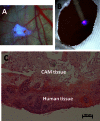Fluorescence characteristics of human Barrett tissue specimens grafted on chick chorioallantoic membrane
- PMID: 26637303
- PMCID: PMC4701780
- DOI: 10.1007/s10103-015-1839-x
Fluorescence characteristics of human Barrett tissue specimens grafted on chick chorioallantoic membrane
Abstract
To improve (pre)malignant lesion identification in Barrett's esophagus (BE), recent research focuses on new developments in fluorescence imaging and spectroscopy to enhance tissue contrast. Our aim was to validate the chorioallantoic membrane (CAM) model as a preclinical tool to study the fluorescence characteristics such as autofluorescence and exogenously induced fluorescence of human Barrett's tissue. Therefore, esophageal biopsy specimens from Barrett's patients were freshly grafted onto the CAM of fertilized hen's eggs to simulate the in vivo situation. The BE biopsy specimens stayed between 1 and 9 days on the CAM to study the persistence of vitality. Fluorescence spectroscopy was performed using six excitation wavelengths (369, 395, 400, 405, 410, 416 nm). Obtained autofluorescence spectra were compared with in vivo spectra of an earlier study. Exogenous administration of 5-aminolevulinic-acid to the biopsy specimens was followed by fluorescence spectroscopy at several time points. Afterwards, the biopsy specimens were harvested and histologically evaluated. In total, 128 biopsy specimens obtained from 34 patients were grafted on the CAM. Biopsy specimens which stayed on average 1.7 days on the CAM were still vital. Autofluorescence spectra of the specimens correlated well with in vivo spectra. Administered 5-aminolevulinic-acid to the biopsy specimens showed conversion into protoporphyrin-IX. In conclusion, we showed that grafting freshly collected human BE biopsy specimens on the CAM is feasible. Our results suggest that the CAM model might be used to study the fluorescence behavior of human tissue specimens. Therefore, the CAM model might be a preclinical research tool for new photosensitizers.
Keywords: 5-aminolevulinic-acid; Barrett’s esophagus; Chorioallantoic membrane; Early detection of cancer; Fluorescence spectroscopy; Protoporphyrin-IX.
Figures





References
-
- Westerterp M, Koppert LB, Buskens CJ, Tilanus HW, ten Kate FJ, Bergman JJ, Siersema PD, van Dekken H, van Lanschot JJ. Outcome of surgical treatment for early adenocarcinoma of the esophagus or gastro-esophageal junction. Virchows Arch. 2005;446:497–504. doi: 10.1007/s00428-005-1243-1. - DOI - PubMed
Publication types
MeSH terms
Substances
LinkOut - more resources
Full Text Sources
Other Literature Sources
Medical

